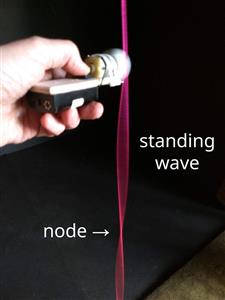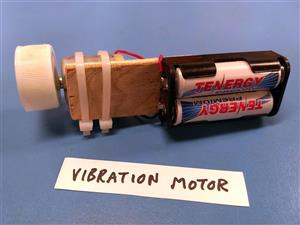Standing Waves in Strings
Introductory/Refresher Activity
Summary: Students simply demonstrate and observe standing waves in strings.
This is a short refresher activity for students who have seen standing waves in strings. This is a short introductory activity for students who have not seen standing waves in strings. It is best if students have previously done a longer activity about waves in strings, including both traveling waves and standing waves.
Time: 5 minutes. Ages: 8 to 16. Number of students: any number.
Materials and Preparation
The only materials needed are a string and a vibration motor. Only one string and motor is needed for a small class of students. For a large class you may want two or three strings and motors.
String
Use thick string or lightweight cord, say, about 2 mm (1/16 inch) thick. It should be highly visible, white or brightly colored. Cut a good length and tie two small end loops make it easier to hold. It should be long enough for a student to step on one end and hold the other end with an upraised hand. For example, cut 180 cm (5 ft 11 in) and tie two end loops to get a final length of 170 cm (5 ft 7 in).
Vibration Motor
Make or buy a hand-held vibration motor to vibrate the hand-held string. The amount of wiggle (the total min-to-max displacement of the eccentric head) should be about 1 cm (1/2 inch). The frequency should be about 30 to 60 cycles per second.
A home-made vibration motor inspires students to see how things work and how to make things. I made a hand-held vibration motor from these parts: 1x4 in (2.5x10 cm) wooden slat, small DC motor, bottle cap as the eccentric (off-center) head, push button switch, battery holder, batteries, electrical wire, solder, zip ties, hot glue. See photos (click to enlarge).
I drilled the hole in the bottle cap about 0.5 cm (1/4 in) off-center so the total vibration displacement is about 1 cm (1/2 in). My DC motor had a small drive gear that made it easy to attach the bottle cap firmly on the shaft. My DC motor spins very fast without anything attached, but with the eccentric head mass it spins slower, about 40 cycles per second. You can experiment with different head weights and offsets until you find something that works to make a standing wave in your string.
Alternatively, you can use any kind of store-bought hand-held gadget that wiggles with a workable displacement and frequency.
Other Visuals
You may want to print or prepare to display some other pictures of standing waves. In particular:
- Animation or diagram of standing wave in a string (see below).
Practice Run
Before the activity, the teacher should practice making a standing wave in a string with at least one node somewhere in the middle.
Activity
Demonstrations
One or two students demonstrate traveling waves and standing waves in a string. All other students observe.
Remember, the purpose of this activity is to be a short refresher on standing waves in strings, not a full activity in itself. So, to keep it quick, just one or two students should demonstrate.
Demonstrate Traveling Waves
A student demonstrates a traveling wave (a moving wave). This is really easy. Hold one end of the string up with one hand, leaving the other end hanging free, not touching the floor. Wiggle your hand side-to-side once or twice and waves will travel down the string. Make sure everyone can see the waves travel down the string.
Demonstrate Standing Waves
A student demonstrates a standing wave (a stationary wave). This is fun. Step on one end of the string with your foot and hold the other end of the string with one hand held up high. Pull the string taut. With your other hand, turn on the vibrator motor and push it gently against the string, about one quarter of the length from the top end. Try moving the vibrator motor up and down to different heights on the string and try pulling the string tighter or looser. Eventually you will find a "sweet spot" where the entire string resonates as a stable standing wave. Alternatively, you can have two students each hold one end of the string in their hands and pull the string taut horizontally. Then one of the two students or a third student can use the vibration motor to make a standing wave.
Make a standing wave with at least one stationary node (still point) somewhere in the middle. The two ends, where the string is held firm, are two nodes, but you should make a wave with at least one more node somewhere in the middle. It's more difficult to make standing waves with more nodes, but for this short demonstration, a standing wave with just one node in the middle is good enough. Try to hold it very steady so everyone can see the node. The node in the middle looks cool!


Animation or Diagram
It's helpful to show this animation or diagram to the students. In real life, a rapidly vibrating string looks like blur. This animation shows a standing wave vibrating more slowly. This works as an animation or as a printed still image. (Click to view separately.)
Observations
All students observe the traveling waves and standing waves. Students should state their observations verbally to the group. The teacher may prompt the students by asking questions about what parts of the string are moving or not moving.
We expect the students to observe the following:
Traveling waves
- The waves move down the length of the string.
- The string wiggles side-to-side.
Standing waves
- The waves do not move up or down the length of the string.
- The string vibrates side-to-side in most places, except at the nodes.
- The nodes do not move much at all, neither side-to-side nor up or down the length of the string.
Vocabulary. By the end of the discussion, students should know these words:
- Traveling wave: a moving wave
- Standing wave: a non-moving (stationary) wave
- Node: a still (stationary) point
For higher grade levels, the teacher may also use these more technical terms:
- Transverse: side-to-side
- Longitudinal: along the length
- Anti-node: position of maximum vibration





